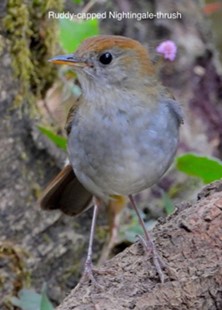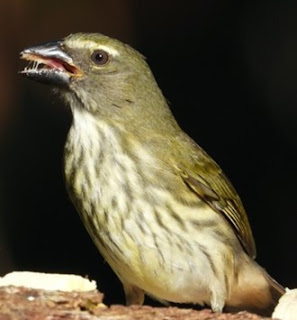Continuing on I made a detour to the Savegre
Hotel Nature Reserve and Spa, a place I had been before with friends of mine
years ago. Noted for birding and natural beauty I lingered for several hours
before pressing on to the Los Cusingos bird sanctuary, home of the former
renowned ornithologist Alexander Skutch. Since I arrived late in the evening
when it was closed, I parked nearby and slept in my car until 7 a.m. when the
sanctuary opened. The administrator, a good friend of ours, recommended a
close-by place to stay for a couple of days. The first day I walked several of
the trails to view whatever nature had to offer. The second day more of the
same, although I spent much of the time stationary in the sanctuary’s garden
hoping to view birds that I have not seen before. Later in the afternoon I made
a side trip to the Las Nubes Biological Reserve associated with York University
in Toronto, Canada. The 124 Ha rainforest reserve provides opportunities for
students, faculty and researchers to focus on projects of community engagement,
education, biodiversity protection, and rural sustainability, among others. After
a guided tour of the facilities, I proceeded to the town of Palmares (about 12
Km south of San Isidro de El General) for supper. When I arrived back at my
cabin I discovered an intruder that somehow managed to get inside. It was a
wild Grey-necked Wood Rail (q.v. photo below).
The next morning I headed to the Wilson
Botanical Garden near the town of San Vito. Along the way I diverted to La
Amistad International Park which covers over 450000 Ha of tropical forest. Part
of the park is shared with Panama and is the largest of its kind in Central
America. I entered the park at the Altimira Station, about 7500 ft. elevation, site
of the park headquarters. I spent about 1.5 hours walking one of the trails,
which was the shortest one of six other trails, the longest being up to 3 days duration.
I arrived at the Wilson Botanical Garden
shortly before noontime for a 2-night stay. The Garden, which also includes the
Las Cruces Biological Station, consists of 365 Ha at an elevation beginning at
3900 ft. Both facilities operate under the direction of the Organization of
Tropical Studies (OTS). Various universities and research institutes from
around the world are affiliated with OTS that conduct studies emphasizing
tropical botany and wildlife. In the latter case, during my stay I spoke with a
postgrad student and professor from Michigan University whom were involved
studying the significance of fungi transport by certain bird species to plants.
The day I was leaving the researchers had captured, in this instance, about 35
Manakins representing 4 different species. Las Cruces owns a total of 326 Ha,
of which about 200 Ha contain primary forest and 10 Ha for the botanical
garden. The remainder of the property consists of secondary forest, pasture and
selectively logged areas. I hiked all of the garden trails to view collections
of marantas, bananas, heliconias, bamboo, palms (over 500 spp.), tree ferns,
araceae, among others. A separate area adjacent to the garden covers over 12 Km
of forest trails, the shortest being 0.7 Km and the longest 3.1 Km. The forest
is classified as a Tropical Premontane Wet Forest (Holdridge) that receives
over 4000 mm of annual rainfall.
On my return to Atenas I chose the pacific
coastal route (Costanera), with a stop at Piedras Blancas National Park.
Unfortunately, unlike the majority of other Costa Rica national parks, the park
was closed, for the time being, due to the lack of proper sanitation facilities
(e.g., a place for washing and sanitizing your hands) related to the Covid-19
pandemic.
The following are some of the photos related
to my journey:
Legend: Wilson Botanical Garden: WBG; Los Cusingos: C; La Amistad International Park: AIP; Quetzal Lodge: QL; Quetzales National Park: QNP; Savegre Hotel Nature Reserve and Spa: SH; Las Nubes Biologico Reserve: NBR;



























































No comments:
Post a Comment